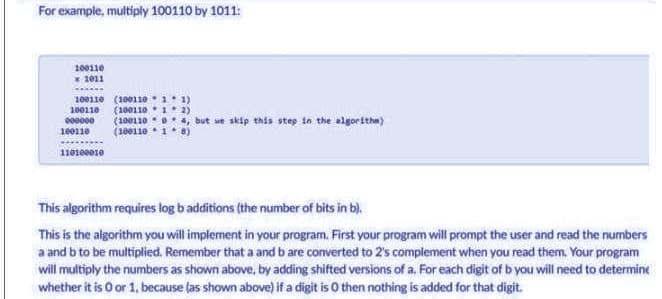For example, multiply 100110 by 1011: 100110 1011 100110 (10011011) 100110 (10011012) 000000 (10011004, but we skip this step in the algorithm) 100110 (10011018) 110100010 This algorithm requires log b additions (the number of bits in b). This is the algorithm you will implement in your program. First your program will prompt the user and read the numbers a and b to be multiplied. Remember that a and b are converted to 2's complement when you read them. Your program will multiply the numbers as shown above, by adding shifted versions of a. For each digit of b you will need to determine whether it is 0 or 1, because (as shown above) if a digit is O then nothing is added for that digit.
For example, multiply 100110 by 1011: 100110 1011 100110 (10011011) 100110 (10011012) 000000 (10011004, but we skip this step in the algorithm) 100110 (10011018) 110100010 This algorithm requires log b additions (the number of bits in b). This is the algorithm you will implement in your program. First your program will prompt the user and read the numbers a and b to be multiplied. Remember that a and b are converted to 2's complement when you read them. Your program will multiply the numbers as shown above, by adding shifted versions of a. For each digit of b you will need to determine whether it is 0 or 1, because (as shown above) if a digit is O then nothing is added for that digit.
Database System Concepts
7th Edition
ISBN:9780078022159
Author:Abraham Silberschatz Professor, Henry F. Korth, S. Sudarshan
Publisher:Abraham Silberschatz Professor, Henry F. Korth, S. Sudarshan
Chapter1: Introduction
Section: Chapter Questions
Problem 1PE
Related questions
Question
-1011: 100110 x 1011 100110 (10011011) 100110 (10011012) 000000 (10011004, but we skip this step in the

Transcribed Image Text:For example, multiply 100110 by 1011:
100110
1011
100110 (10011011)
100110 (10011012)
000000 (10011004, but we skip this step in the algorithm)
(10011018)
100110
110100010
This algorithm requires log b additions (the number of bits in b).
This is the algorithm you will implement in your program. First your program will prompt the user and read the numbers
a and b to be multiplied. Remember that a and b are converted to 2's complement when you read them. Your program
will multiply the numbers as shown above, by adding shifted versions of a. For each digit of b you will need to determine
whether it is 0 or 1, because (as shown above) if a digit is 0 then nothing is added for that digit.
Expert Solution
This question has been solved!
Explore an expertly crafted, step-by-step solution for a thorough understanding of key concepts.
Step by step
Solved in 5 steps with 3 images

Knowledge Booster
Learn more about
Need a deep-dive on the concept behind this application? Look no further. Learn more about this topic, computer-science and related others by exploring similar questions and additional content below.Recommended textbooks for you

Database System Concepts
Computer Science
ISBN:
9780078022159
Author:
Abraham Silberschatz Professor, Henry F. Korth, S. Sudarshan
Publisher:
McGraw-Hill Education

Starting Out with Python (4th Edition)
Computer Science
ISBN:
9780134444321
Author:
Tony Gaddis
Publisher:
PEARSON

Digital Fundamentals (11th Edition)
Computer Science
ISBN:
9780132737968
Author:
Thomas L. Floyd
Publisher:
PEARSON

Database System Concepts
Computer Science
ISBN:
9780078022159
Author:
Abraham Silberschatz Professor, Henry F. Korth, S. Sudarshan
Publisher:
McGraw-Hill Education

Starting Out with Python (4th Edition)
Computer Science
ISBN:
9780134444321
Author:
Tony Gaddis
Publisher:
PEARSON

Digital Fundamentals (11th Edition)
Computer Science
ISBN:
9780132737968
Author:
Thomas L. Floyd
Publisher:
PEARSON

C How to Program (8th Edition)
Computer Science
ISBN:
9780133976892
Author:
Paul J. Deitel, Harvey Deitel
Publisher:
PEARSON

Database Systems: Design, Implementation, & Manag…
Computer Science
ISBN:
9781337627900
Author:
Carlos Coronel, Steven Morris
Publisher:
Cengage Learning

Programmable Logic Controllers
Computer Science
ISBN:
9780073373843
Author:
Frank D. Petruzella
Publisher:
McGraw-Hill Education